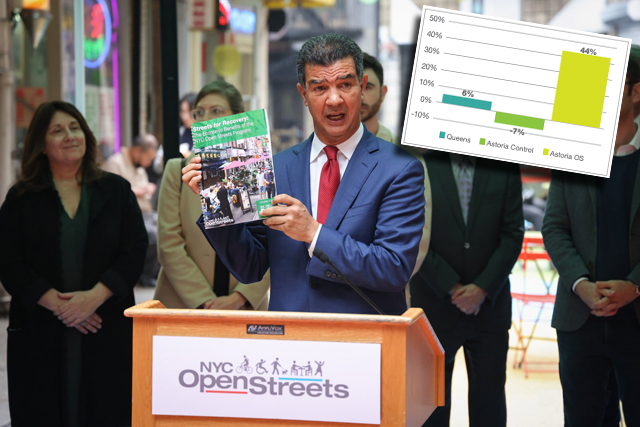Maybe this will silence the skeptics.
City officials brandished a new tool in the fight against opponents of taking public space back from car drivers — a new report showing that business is booming along streets that have been converted to outdoor dining strips or car-free open streets.
Department of Transportation Commissioner Ydanis Rodriguez said the report released on Tuesday by his agency and Bloomberg Associates should put to rest a contentious debate over the future of the Open Restaurants program, which the City Council may limit to only warm weather months or restrict in the curbside lane — both parts of the program that saved thousands of restaurants and tens of thousands of jobs.
Today we announced, "Streets for Recovery: The Economic Benefits of NYC Open Streets Program," a groundbreaking report developed in collaboration with @BloombergAssoc, with @NYCFinance data, which highlights the economic benefits of Open Streets.
— NYC DOT (@NYC_DOT) October 25, 2022
Read: https://t.co/NfGqaX9xAp pic.twitter.com/5w3MdpBr7V
Of course restaurants should operate in the curbside lane, Rodriguez said when asked at a press conference in Chinatown if he's concerned about the Council's pending measure.
"They're always going to be moments where [people] express a different point of view," he said, "but at the end of the day, everyone agrees Open Streets and Open Restaurants are a good thing for our city. ... The future of New York City is going car free. So ... we are working with advocates, with schools, with experts to be sure that we are reimagining the use of public space."
That's far different language than what's been spoken by Council Speaker Adrienne Adams. The southeast Queens lawmaker said her personal opinion is that restaurant dining areas should not be in the roadway.
“Outdoor dining, in my perspective, should be sidewalk," Adams said at a Citizens Union breakfast on Sept. 28 when asked about the pending Council legislation to make the Open Restaurant program permanent. (She later clarified that she was just expressing her personal opinion, and her office declined to comment on the new report).
Do you blame bail reform for crime increase? “While I believe it plays a role,” Speaker Adams says, “it’s been scapegoated as the end-all, be-all.” Praises reform as dealing with the inequities. But - like the mayor and Gov - says judges should have more discretion.
— Jeff Coltin (@JCColtin) September 28, 2022
It's clear from the data that streets for people moseying through rather than car drivers rushing past are the best for businesses.

The city analyzed tax sales before and during the pandemic from bars and restaurants on five open streets — Ditmars Boulevard in Astoria, Pell and Doyers streets in Chinatown, E. 32nd Street in Koreatown, Fifth Avenue in Park Slope, and Vanderbilt Avenue in Prospect Heights — and found that businesses on open streets experienced more economic growth than those on comparable commercial streets in the same neighborhoods as well as the borough overall (see graphic right):
- In Astoria, the open street on Ditmars Boulevard not only experienced more economic growth than a non-open street portion of the same roadway — a 44-percent increase in sales compared to a 7-percent decline on the control street — but also fared better than the entire borough of Queens, which experienced a 6-percent increase in sales over the same period.
- In Prospect Heights, the Vanderbilt Avenue open street sparked a 20-percent increase in taxable sales — 14 percent more than Brooklyn as a whole and 60 percent more than the control corridor.
- And while Manhattan experienced a 22-percent drop in sales, Chinatown's open street experienced only an 8-percent drop — far less of a drop than the neighboring control street, which was down 31 percent.
The DOT and Bloomberg Associates also studied the tax filings of businesses on the five open streets before and during the pandemic and found that new bars and restaurants popped up at a faster rate on the open streets than they did on the control corridors or across the borough as a whole.
On Fifth Avenue in Park Slope, for example, the number of businesses rose by 18 percent, compared to a 24-percent drop on the control corridor, Seventh Avenue, and a 7-percent drop throughout Brooklyn, according to the data, which included filings from the Department of Finance pre-pandemic from March 1, 2017 to Feb. 29, 2020 and during the pandemic between March 1, 2020 and Aug. 31, 2021.
“This ground-breaking report confirms with data what we believed anecdotally, which is that the recipe of Open Restaurants mixed with Open Streets, enhances the already strong economic and social benefit and impact of outdoor dining,” said Andrew Rigie, the executive director of NYC Hospitality Alliance.
And the report follows Streetesblog’s own analysis of tax filings after the 2017 installation of a controversial bike lane on Skillman Avenue in Queens.
Despite fears that the bike lane would completely kill mom-and-pop shops along the commercial stretch, data bought by Streetsblog from the city Department of Finance showed that sales actually rose by 12 percent, and that new businesses jumped 10 percent.
The pandemic hit the city’s bar and restaurant industry extraordinarily hard, with thousands of people losing their jobs, and a 50-percent drop in sales citywide, including more than 70 percent in Manhattan.
“As New York City comes back, this program will continue to be a critical driver of a strong, equitable recovery," Mayor Adams said in a statement. "This report echoes what we have heard in communities across the city: Opening our streets can kickstart small businesses, create jobs, and lift up neighborhoods. Our administration will continue working to craft a permanent outdoor dining program that will keep local restaurants vibrant and that all New Yorkers can be proud of."






